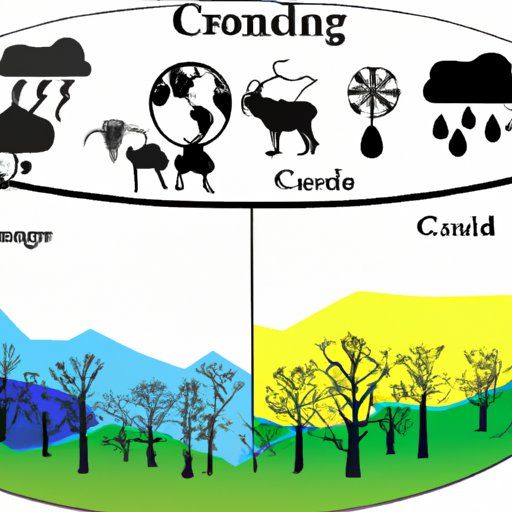Introduction
Climate change is a term used to describe the changes in temperature, precipitation, wind, and other environmental factors that are occurring over time due to natural and human-induced processes. The Earth’s climate has always been changing, but in recent years, these changes have accelerated at an unprecedented rate. This article will explore the science behind climate change, examining its causes, effects, and possible solutions.
Examining the Causes and Effects of Climate Change
The primary cause of climate change is the emission of greenhouse gases (GHGs) into the atmosphere. These gases absorb and trap heat from the sun, causing the Earth’s average surface temperature to rise. GHGs are emitted both naturally and as a result of human activities such as burning fossil fuels for electricity and transportation. While natural processes such as volcanic eruptions, wildfires, and deforestation can contribute to GHG emissions, the majority of emissions come from human activities.
Rising levels of GHGs have led to an increase in global temperatures, which is having a profound effect on the environment. For example, higher temperatures are melting glaciers and sea ice, leading to rising sea levels and increased flooding in coastal areas. Higher temperatures are also causing droughts in some regions, leading to decreased crop yields and food insecurity. In addition, higher temperatures are affecting the habitats of many species, leading to extinction and disruption of migration patterns.
Exploring the Impact of Climate Change on Human Health
Climate change is also having a significant impact on human health. Warmer temperatures can lead to an increase in heat-related illnesses, such as heat exhaustion and heat stroke. In addition, air pollution levels tend to be higher in warmer climates, leading to an increase in respiratory and cardiovascular diseases. Finally, warmer temperatures can also lead to an increase in vector-borne diseases, such as malaria and dengue fever.
Investigating the Role of Greenhouse Gases in Climate Change
Greenhouse gases are the primary driver of climate change. The most common GHGs are carbon dioxide, methane, nitrous oxide, and fluorinated gases. These gases occur naturally in the atmosphere, but they are also released through human activities such as burning fossil fuels and deforestation. GHGs trap heat from the sun, causing the Earth’s average temperature to rise. Different gases have different global warming potentials, meaning that some gases are more effective at trapping heat than others.

Understanding the Interactions between Climate Change and Biodiversity
Climate change is also having a significant impact on biodiversity. As temperatures rise, species are forced to migrate to cooler climates or face extinction. In addition, habitat destruction due to human activities such as deforestation is further exacerbating the issue. As species are lost, so too are the benefits they provide, such as pollination, nutrient cycling, and pest control.

Assessing the Economic Impacts of Climate Change
The economic impacts of climate change are far-reaching. Rising sea levels are eroding shorelines and destroying coastal infrastructure, while higher temperatures are decreasing crop yields and disrupting tourism. In addition, businesses may be forced to invest in expensive technologies to reduce their GHG emissions, leading to higher costs and reduced profits.

Analyzing the Relationship between Climate Change and Agriculture
Agriculture is particularly vulnerable to the effects of climate change. Higher temperatures can lead to water stress, which can reduce crop yields. In addition, warmer temperatures can also increase the prevalence of pests, leading to crop damage and loss. Finally, soil erosion caused by increased precipitation can reduce the fertility of agricultural soils.

Evaluating Solutions to Combat Climate Change
Fortunately, there are a number of steps that can be taken to mitigate the effects of climate change. Renewable energy sources, such as solar and wind power, can help reduce GHG emissions. Carbon capture and storage technologies can also be used to capture and store GHGs before they enter the atmosphere. Finally, sustainable land management practices, such as reforestation and conservation, can help reduce GHG emissions and protect ecosystems.
Conclusion
In conclusion, climate change is one of the most pressing issues facing the world today. Its causes and effects are wide-ranging, impacting not only the environment, but also human health and the economy. Fortunately, there are a number of solutions that can be implemented to combat climate change, such as renewable energy sources, carbon capture and storage technologies, and sustainable land management practices. It is essential that we take action now in order to prevent further damage to our planet.
(Note: Is this article not meeting your expectations? Do you have knowledge or insights to share? Unlock new opportunities and expand your reach by joining our authors team. Click Registration to join us and share your expertise with our readers.)
